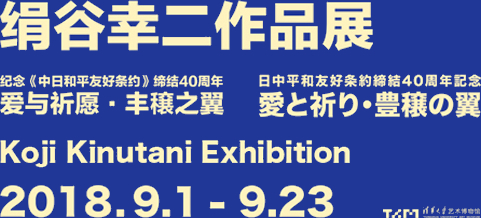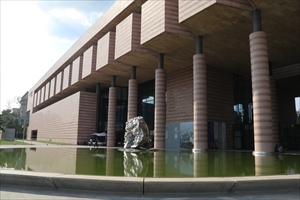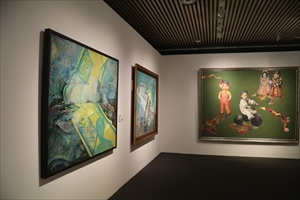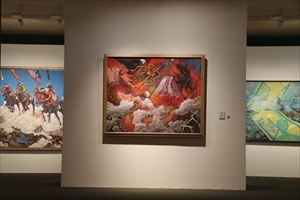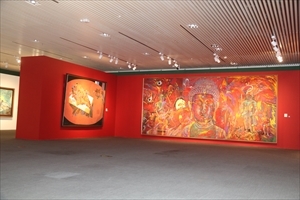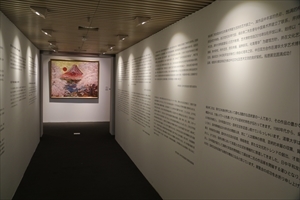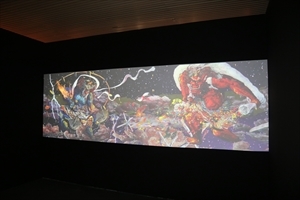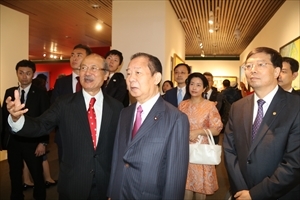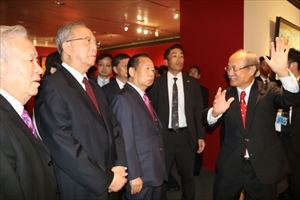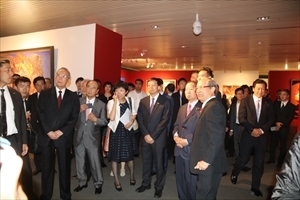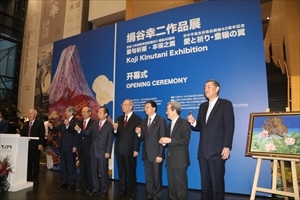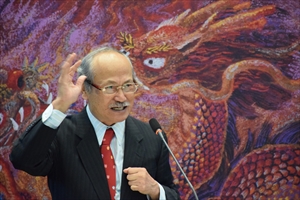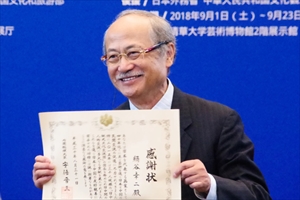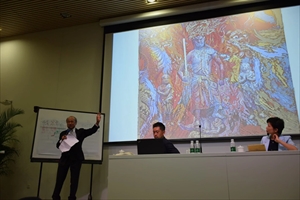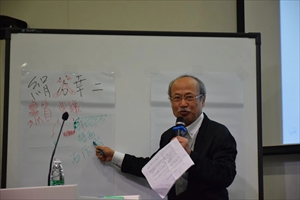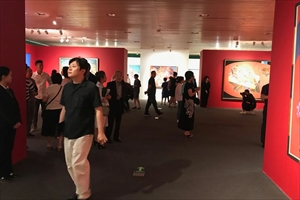北京・清華大学芸術博物館The Tsinghua University Art Museum in Beijing, China
- フォトギャラリーPhoto Gallery
- カタログCatalog
- kinutani_china_exhibition_catalogue.pdf
- 映像記録Video Recording
- 会期Exhibition dates
- 2018年9月1日(土)~9月23日(日)|September 1 (Sat.)- September 23 (Sun), 2018
- 開館時間Hours
- 午前9時~午後5時|Regular hours 9:00AM - 5:00PM (admission until 4:30PM)
- 休館日Closed
- 月曜日(法定休暇を除く)|Mondays (Except for statutory holidays)
- 主催Organizer
- 日中交流促進実行委員会|Japan-China Exchange Promotion Committee
清華大学|Tsinghua University - 後援Support
- 外務省|MOFA
中国文化旅遊部|Chinese culture traveling department - 協賛Sponsorship
- 積水ハウス 株式会社|Sekisui House, Ltd.
プリヴェ企業再生グループ 株式会社|Privee Turnaround Group Co., Ltd. - 協力Cooperation
- 吉井画廊|Yoshii Gallery
株式会社 アトリエシルキー|Atelier Silky Co., Ltd - 観覧料Admission
- 20元|20 yuan
- 所在地Location
- 北京・清華大学芸術博物館|The Tsinghua University Art Museum in Beijing, China
北京市海淀区清華大学内|NO. 1, Tsinghua University Campus, Hai Dian District, Beijing - アクセスマップAccess map
- 日中平和友好条約締結40周年記念・清華大学藝術博物館 絹谷幸二展作品解説Koji Kinutani Exhibition Tsinghua University Art Museum Commemorating the 40th Anniversary of the Conclusion of the Treaty of Peace and Friendship between Japan and China.
-
南城 守(絹谷幸二天空美術館 顧問・キュレーター)
Nanjo Mamoru(Advisor/Curator, Koji Kinutani Tenku Art Museum)第一章・「形成-開花」1960~70年代
日本の古都・奈良で生まれ、幼少時から奈良の歴史や仏教など藝術的環境によって豊かな感性を育くんできた絹谷幸二は、やがて画家を夢見るようになり、東京藝術大学油画科に進学。本格的に藝術家としての基礎を築いていった。
藝大時代の油彩画は、単色系の混沌とした画面構成だったが、その後、アフレスコ古典壁画と出会い、恩師ブルーノ・サエッティ氏に勧められヴェネツィア・アカデミアに留学。本格的にアフレスコ古典技法修得に邁進する。
イタリアへの留学を契機に画風は一変。アフレスコの模写研究によって輪郭線の重要さを認識し、明るく平明な画面構成を体得。そして色彩と筆あとを輪郭線で囲むリズミカルな「線」が誕生する。色彩がほとばしり歓喜の歌声が奏でられる絹谷スタイルの誕生である。帰国後はアフレスコによる斬新な表現で一躍時代の寵児となる。文字が画面にあふれ出る独特の表現は、後進の漫画やアニメ世代の画家たちに大きな影響を与えるものであった。Chapter I: "Development - Maturation" 1960-1970
Koji Kinutani was born in the ancient capital of Japan, Nara. Being a highly historical and religious city, Kinutani was surrounded by an artistically rich environment since childhood. As he grew older, he naturally aspired to become a painter. He built his foundations as an artist at the Oil Painting department at the Tokyo National University of Fine Arts.
Kinutani's oil paintings during his university years were distinctively monochromatic and chaotic in structure. Shortly later, he encountered with classical fresco paintings. With the recommendation by his teacher, Bruno Saetti, Kinutani entered the Academy of Fine Arts of Venice to master the classical fresco technique.
Kinutani's time in Italy transformed his painting style entirely. Through copying fresco paintings countless times as part of his training, Kinutani learnt the importance of the contour line, and achieved a lighter and a more flat expression. The signature Kinutani-style of the rhythmic "line" and vibrant colors was born. After returning to Japan, he rose to fame with his innovative fresco painting style. His unique style of overflowing the canvas with texts had a major influence on younger generation of painters who grew up in the manga and animation culture.第二章・「革新-立体の誕生」1980~90年代
アフレスコ古典技法を駆使し、豊麗な色彩とリズミカルな線描表現で一世を風靡した初期のスタイルからの脱皮と、新たなる挑戦が始まる。これまでの大きな特徴であった輪郭線が画面から消え、「点描表現」や「砂シリーズ」が生まれる。やがてキュビスム(立体主義)的表現を志向し、画面に凹凸を求めたレリーフ状の作品、さらにはスチロフォームで彫刻し着色した立体作品が誕生する。二次元(絵画)に三次元(彫刻)にと絹谷芸術はさらにスケールアップしていく。この時期の画題の多くが、混迷する世界情勢に警鐘を鳴らし、平和への祈りを掲げるものであった。Chapter II: "Innovation - Birth of Three-dimensional Art" 1980-1990
During this period, Kinutani grew out of his early painting style which made full use of the classical fresco technique and was characteristic of vibrant colors and rhythmical lines. The contour line, which was one of the largest features of his early style, disappeared from his paintings. Instead, the "Pointillism expression" and his "Sand Series" were born. Eventually, Kinutani leaned towards cubism. Kinutani's art scaled up from 2D (paintings) to 3D when relief-style works and three-dimensional sculptures made of styroform were created. Many of the works which were created during this time addressed the modern chaotic social climate, and cried out for world peace.Nella Sabia
Nella Sabia(In the Sand)1982
181.8×227.3cm
連華夢譚
Dream Tale of a Lotus Flower1983
194×259cm
オスロー
Oslo1989
270×179×40cm
Yes or No
Yes or No1997
133×168cm
Noi Amiamo
Noi Amiamo (We are in Love)1997
194×259cm
第三章・「飛躍-豊饒(ほうじょう)なる心象(しんしょう)」2000年代~最新作
2000年代に入り、絹谷は様々なテーマに挑戦し、百花繚乱の様相を呈して行く。旭日(きょくじつ)に輝く富士山から、日本の神話・伝承を題材とした古代幻想、そして龍や不動明王、さらには風神雷神や七福神まで、日本や東洋を象徴するモチーフが画面狭しと躍動し、人間の「想像=創造」力の無限の可能性を示唆するような豊饒なるイメージが展開される。
パワフルな絵画世界の根底に一貫して流れるのは、幼少時代に培った仏教的思想、「無常観」や「不二法門」の教えである。そして常日頃から「美術はいかなる武器よりも力を持つ」という藝術への理想、信念を抱きながら、世界の平和を願い、人間信頼へのメッセージを発信し続けている。Chapter III: "Flight - A Rich World of Image" 2000 - latest works
From the 2000's, Kinutani challenged various themes, and his artistic developments reached full maturity. Motifs that represent Japan or Asia ― such as Mt. Fuji and the rising sun, fantastic images inspired by Japanese myths and legends, dragons, Acalanantha (a fierce Buddhist deity), Wind God and Thunder God, and the Seven Gods of Good Fortune ― filled the canvas. These rich images, full of life, suggested the infinite possibilities of mankind's imagination and creativity.
The Buddhist teaching of "Mujo-kan (a view of life as something transient and empty)" and "Funihomon (dharma-gate of non-duality)" underlines the powerful art world of Kinutani. With a strong belief that "Art has a power stronger than any weapon," Kinutani continues to call for world peace and trust in humanity through his creations.飛鳥華薫る
Life, Flowers in a Chinese Pottery2002
60.6×72.7cm
菩提心
Bodhicitta(Seeking for Enlightenment)2003
259×582cm
天空の調
Melody of the Sky2003
194×259cm
日輪天祥慈愛
Sun, Heavenly Felicity, Benevolence2005
194×259cm
蒼天富嶽双龍飛翔
Blue Sky, Mt. Fuji, and Flying Dragons2010
194×259cm
平和を祈る自画像(発火激情)
Self-Portrait Praying for Peace (Igniting Passion)2010
194×259cm
蓮華・祈り
Lotuses and a Prayer2011
72.7×60.6cm
緑に染まる思い出
Memories, to be Dyed Green2012
181.8×227.3ccm
緑に染まる思い出
Memories, to be Dyed Green (Peko-chan and I)2017
194×259cm
金戒光明寺
Monju Bosatsu (Manjusi) Descends to Konkai Komyo-ji TempleⅡ2018
162×194cm
日月春春湖上不二
Sun, Moon, Spring, Mt. Fuji on the Lake2018
133×168cm
不二法門
Dharma-Gate of Non-Duality2018
133×168cm
不動明王
The Buddhist God Acalanatha (Benevolence, Merciful Heart)2018
181.8×227.3cm
- 絹谷幸二略歴Koji Kinutani Biography
-
絹谷はシルクロード伝来の古都奈良・興福寺の麓に生まれ、画家を志し、東京藝術大学で絵画を専攻し同大学院を卒業。初訪中は日中平和友好条約が締結されて間もない1980年、北京・西安・敦煌を旅行。1986年少林寺壁画制作のため少林寺へ取材旅行。1993年、国際交流基金の文化派遣事業により北京・中央美術学院にて1ヶ月にわたり「環境芸術」の特別講義を行う。同年、中国美術館にて東京芸術大学・絹谷幸二教室の生徒及び中国の美術家と「日中現代油画展」を開催。1998年、長野冬季オリンピック・パラリンピック公式ポスター「銀嶺の女神」ほか7種類の競技別ポスターの原画制作を行う。同年、日本中国文化交流協会代表団として團伊玖磨団長らと訪中。
2006年、湖南省長沙で開催された第一回中国中部貿易投資博覧会の日本代表団団長として千人を率いて訪中。2008年、北京にて観光庁特別アドバイザリー・ボードとして「観光客誘致のための」シンポジウム開催。上海にて「日本・関西・奈良を語る集い」にてパネリストとして参加。同年、奈良を訪問した胡錦濤国家主席と面会。奈良東大寺の鑑真大和上像を中国へ里帰りをさせる文化企画を立案、成功させる。2010年、日本中国文化交流協会理事に就任。同年、上海万国博覧会の日本産業館に天井画LED「日月天飛翔」を制作。2011年成都現代美術館「ビエンナーレ」招待作家。2000年より、自由民主党二階俊博先生に随行し大型ミッション5千人・1万3千人・2万5千人の訪中団として参加。2014年、文化功労者となる。2015年、第66回日本放送協会・放送文化賞受賞。同年、「日中観光文化交流団」3千人の団長を務める。2017年、京都国立近代美術館にて「絹谷幸二・色彩とイメージの旅」展開催。同年、日本与党経済代表団にて訪中。習近平国家主席、中国人民対外友好協会・李小林会長、清華大学・邱勇学長と面会。
現在、東京藝術大学名誉教授。日本芸術院会員。独立美術協会会員。絹谷幸二・天空美術館名誉館長。日中文化交流協会理事として日中相互交流に尽力している。Koji Kinutani was born near the Kofuku-ji temple in Nara, the ancient capital of Japan. Aspiring to become a painter, he studied at the Oil Painting Department at the Tokyo National University of Fine Art and Music, and graduated from the university's graduate school. In 1980, shortly after the Japan-China Peace and Friendship Treaty was concluded, Kinutani made his first trip to China and traveled from Beijing, Xi'an to Dunhuang. In 1986, he traveled to Shaolin Temple to create mural paintings on the walls of the temple. In 1993, he held special lectures on "Environmental Art" for one month at the Central Academy of Fine Arts in Beijing as part of a cultural dispatch program of the Japan Foundation. In the same year, the "Japan-China Contemporary Oil Painting Exhibition" was held at the National Art Museum of China, exhibiting works by Chinese artists and Kinutani's students from the Tokyo National University of Fine Arts. In 1997, Kinutani was commissioned to design the official poster for the Olympic & Paralympic Winter Games in Nagano and individual posters for seven different sports, including his work, "Ginrei no Megami (Goddess of the Silvery Peak)." In the same year, he visited China with Dan Ikuma as a member of the Japan Cultural Exchange Association delegation.
In 2006, as head of the Japanese delegation of the 1st Expo Central China held in Changsha, Hunan Province, Kinutani led a thousand people from Japan to China. In 2008, as a Special Advisory Board of the Tourism Agency in Beijing, he held the "Symposium for Attracting Tourists" and participated as a panelist at the "Gathering for Japan, Kansai and Nara" in Shanghai. In the same year, Kinutani met with President Hu Jintao in Nara, and succeeded in conducting the cultural project to take the statue of Ganjin Wajo of Nara Todai-ji temple back to its home country, China. In 2010, he was appointed as the director of the Japan Cultural Exchange Association. In the same year, he produced an LED ceiling painting "Flying Surya and Chandra" for the Japan Industry Pavilion at the Shanghai World Exposition. In 2011, he was invited as a guest artist for the Chengdu Biennale. Since 2000, Kinutani has accompanied Toshihiro Nikai of the Liberal Democratic Party of Japan on a grand mission to lead the Japanese delegation of 5000, 13000, and 25000 people to China. In 2014, Kinutani was accredited as Person of Cultural Merit. In 2015, he received the 66th NHK Broadcasting Culture Award (by the Japan Broadcasting Corporation). In the same year, he served as head of the "Japan-China Tourism Cultural Exchange Group" of 3,000 people. In 2017, the exhibition, "Koji Kinutani, A Journey of Color and Imagery" was held at the National Museum of Modern Art, Kyoto. In the same year, he traveled to China as a member of the Ruling Party Economic delegation and met with President Xi Jinping of the People's Republic of China, President Li Xiaolin of the Chinese People's Association for Friendship with Foreign Countries, and President Qiu Yong of Tsinghua University.
Kinutani is currently a professor emeritus of the Tokyo National University of the Arts and Music, a member of the Japan Art Academy and the Independent Society of Fine Art, and an Honorary Director of the Koji Kinutani Tenku Art Museum. As the director of the Japan-China Cultural Exchange Association, Kinutani continues his mission to promote mutual exchange between Japan and China. - 展覧会への寄稿文Texts on the Exhibition
-
建畠 晢(多摩美術大学学長/埼玉県立近代美術館館長)「絹谷幸二の世界」(展覧会カタログ『絹谷幸二 色彩とイメージの旅』掲載)
画家は段階的に作風を形成していくことが多いが、機が熟した時、一挙に自らの世界を確立してみせる画家もいないわけではない。若くして安井賞を受賞した絹谷幸二もその一人で、アフレスコ・ストラッポによる受賞作<アンセルモ氏の肖像>(1973年)において彼は今日までの長い画業を貫いてきた独自のパッショネイトな表現を典型的なかたちで出現させたのである。それは大きな飛躍でありながらも、イタリアにおける技法的、色彩的、形象的な探究の結節点とも見なしうる、まさにモニュメンタルな意味をもった作品であったといわなければなるまい。
輪郭線で稲妻のように切り取られた流動的なスピード感に満ちた形象が登場してきたこと、赤を基調にした鮮烈な色彩が用いられていること、一種神話的なイメージの創出のエネルギーにあふれていると同時に、どこか崩壊や破壊の感覚を宿してもいること。オブジェや光景の捉え方に密かにキリコの形而上学的絵画にも通じるところがあること。そして不可思議な謎をはらんだ、絹谷ならではのユーモラスなポップ感覚。
こうしたユニークな特質は宇宙大のスケールへと拡大されながらも、基本的には最近作に至るまで維持されてきているものである。今回の回顧展が「色彩とイメージの旅」と題されているのも、絹谷の制作の軌跡が、きわめて豊饒な多様性を有しながらも、安井賞の時点で自らの資質を見極め、画家としての一筋の道を歩むことであったという自負心を表しているのかもしれない。ちなみに<アンセルモ氏>とはベネチア留学中に彼が親しくしていた画家で、周囲から注目されながらもなぜか画業を離れ、やがてインドで消息を絶ったという。画面の顔がもはや肖像といいえぬほどに崩壊しつつあるのも、絵筆による予感であったと絹谷は記している。
生成と崩壊の感覚が共存するということは、見方によっては絹谷の作品は愛と死の、あるいは絶望と救済の両義性をはらんでいるということでもあるだろう。私たちが絹谷の世界に魅せられて止まないのは、実はバイタリティーに満ちた華麗なる表現の背後にある、陰の部分をも見据える画家の思索の深さのゆえであるのかもしれない。たとえば<砂の中>(1982年)では赤い砂漠の大地で柩のような箱の中に横たわって愛し合う男女が描かれている。傍らに砲弾のごときものが転がっているからには、ここは戦場であろうか。箱の内側にはひらがなが、砂地の上には"無"の字や般若心経の断片が配されている。そこに直線的なストーリーが読み取れるわけではないが、私には不寛容さによる紛争が絶えない状況にあって、愛に希望を託す画家の祈りが静かに伝わってくるように思われたのである。
<ノン・ディメンティカーレ(忘れないで)>(1994年)は絹谷にしては珍しく色彩は暗く抑制され(といっても赤や青は部分的に使用されているが)、戦争による破壊や殺戮、廃墟の光景が大画面にびっしりと描き込まれている。下辺には"PIKKA DON"の文字も見られる。この画家は絵画は審美的に鑑賞されるばかりではなく、いやむしろそうであるからこそ、絵筆によってしか伝えることのできないメッセージを有していると考えているに違いない。その意味では彼の作品はいかにポップ的な現代性を帯びてはいても、宗教画な思索とも無縁ではないところに位置しているのである。
もう一つ注目されてよいのは、アフレスコ・ストラッポをはじめとする絵画の技法への探求が、1980年代後半になるとスティロフォームによる立体作品を派生させていくことである。<オープン・ザ・ボックス・オブ・パンドラ>(1990年を見れば分かるように、イメージの断片化、色彩の豊潤さ、文字の導入、構築性と破壊などの<アンセルモ氏の肖像>以来の特質は絵画からそのまま持ち込まれ、しかもより混沌とした趣を強めているのだ。まさにパンドラの箱を開けたように、である。
さて、昨年末、大阪の梅田に「絹谷幸二 天空美術館」がオープンした。館名通り、大阪の街を見下ろすビルの高層階に位置する美術館で、展示は近作、新作を中心としているが、私にとってもっとも興味深かったのは3Dの映像の上映であった。卓抜な技術によって、富士山や風神雷神の図などの世界に突入して行く体験が可能になり、イメージがダイナミックに連鎖するこの画家ならではの流動的な画面が大胆に拡大され、また神話的な物語性や宇宙感覚などを生かすなど、映像に絵画を取り込むという困難なだけにスリリングでもある実験に成功していた。絹谷の広範な制作の軌跡を一望できる本展に期待するとともに、新たに試みられると聞く映像も楽しみにしたい。Akira Tatehata(President, Tama Art University / Director, The Museum of Modern Art, Saitama) , "The World of Koji Kinutani" (Published in the exhibition catalog, Koji Kinutani A Journey of Color and Imagery)
Although painters usually develop their style gradually, there are some who succeed, when the time is ripe, in suddenly establishing a world of their own. Among them is Koji Kinutani, who won the prestigious Yasui Prize at a young age. With the prizewinning work Portrait of Mr. Anselmo (1973), which employs the technique of fresco strappo (removing the paint layer of a wall fresco and applying it to another support), he embarked on a long journey that continues to this day, in which he makes unique and passionately expressive use of a classical medium. The 1973 work represents a spontaneous creative leap, and at the same time it is of monumental significance as a consolidation of his technical, chromatic, and graphic explorations carried out in Italy.
The emergence of dynamic forms with a strong sense of velocity, surrounded by contour lines resembling strokes of lightning, the vivid palette with red as a base tone, the somehow mythological imagery that is both overflowing with energy and imbued with a sense of collapse and destruction. Such depiction of objects and scenes is closely connected to the metaphysical painting of Giorgio de Chirico. Kinutani's distinctive, humorous Pop sensibility is full of mystery and wonder.
These unique qualities have essentially remained in Kinutani's work until recently, although they have grown in scale over the years until they seem to encompass an entire universe. This retrospective is subtitled A Journey of Color and Imagery, perhaps reflecting the artist's recognition that he has trod a single path since ascertaining his own artistic qualities with his receipt of the Yasui Prize, although it has been an exceedingly diverse and fertile one. Incidentally, the Mr. Anselmo of the painting was a painter with whom Kinutani was close friends when he was studying abroad in Italy, and although he was gaining some recognition as an artist, he for some reason gave up painting and went to India, where he disappeared. His face in the painting is so deconstructed that it can hardly be called a portrait, and Kinutani has written that his brush may have foreseen Anselmo's fate.
Depending on one's viewpoint, the coexistence of generative and disintegrative forces in a single painting could indicate that Kinutani's work is imbued with the ambiguity of love and death, despair and salvation. Kinutani's world may fascinate us because of the artist's depth of thought, the way he peers into the shadows lurking behind the brilliant, vital scenes he depicts. NELLA SABBIA(in the Sand)(1982), for example, depicts a man and a woman lying entwined in an embrace in a coffin-like box lying amid the red desert sands. Objects resembling shells are lying around them, indicating that this may be battlefield. Hiragana are written on the inside of the box, and the kanji mu (nothing) and fragments of the Heart Sutra are inscribed on the sand. We cannot read any story directly, but the painting quietly conveys the artist's prayers that love will conquer in a world constantly wracked by wars springing from intolerance.
Non Dimenticare (Do not Forget)(1994) is anomalous among Kinutani's works for its dark, somber tones(although red and blue are partially used), and the large canvas presents a vista of destruction, massacre, ruins and other horrors of war. The words pika don (an onomatopoetic representation of the atomic bomb's light and sound) are written near the bottom. Despite, or perhaps because of, the fact that the artist's works are often viewed with an aesthetic and sensual eye, the work delivers a message that could only be delivered through brushwork. In this sense, Kinutani's paintings have an affinity with religious art and the philosophy attending it, no matter how contemporary and "Pop" a sensibility they may present.
Another notable point is that Kinutani's exploration of painting techniques like fresco strappo later led to his three-dimensional Styrofoam works in the late 1980s. A work such as Open Pandora's Box (1990) displays characteristics evident since the era of Portrait of Mr. Anselmo, such as fragmented images, saturated color, inclusion of text, and elements of construction and destruction, and is even more powerfully chaotic. Indeed, it is just like opening Pandora's box.
At the end of 2016, the Koji Kinutani Tenku Art Museum opened in Umeda, Osaka. It is located on a high floor of a building overlooking the city of Osaka, and primarily features new and recent works. What fascinates me the most is the screening of 3D images. Through state-of-the-art technology, viewers can be immersed in a world of imagery such as Mount Fuji and the Wind and Thunder Gods, with mythological narrative and galactic scale, where paintings featuring fluid, dynamically linked images such as only this artist could create are boldly enlarged. Kinutani has succeeded in a challenging, and thus thrilling experiment in incorporating painting into video. I look forward to seeing these new experiments with the moving image, as well as the overview of the arc of Kinutani's great, long and diverse journey that this exhibition offers. - 「絹谷幸二 個展に寄せて」Message for the Koji Kinutani Exhibition
-
絹谷 幸二
日中平和友好条約締結40周年を記念して、絹谷幸二絵画展を中国 北京 清華大学芸術博物館で開催されますことは、私にとりまして望外の喜びです。
思えば40年前、壁画研究のため敦煌に出向いて以来、私は日本中国文化交流協会会員として、中国の文化人の皆さんと永年交流を続けて参りました。
1993年 国際交流基金の文化派遣事業により中央美術学院にて1ヶ月間 ア・フレスコ画実技指導を行いました。近年では2000年頃より二階俊博先生と共に、湖南省長沙で開催された第一回中国中部貿易投資博覧会の日本代表団団長として千人を率いて訪中し、再々に渡り三千人・五千人・一万人の日本人観光客を先導し、日中の観光交流を続けて参りました。
所で私は、1200年以上も前、中国の鑑真和上が来日された奈良 唐招提寺の近くで生を受けました。日中の交流は何千年に渡って営々と続けられて参りました。今後もこの交流の大河を途絶えることなく続け、このアジアに多彩な文化の華を咲かせなければならないと考えています。私どもは共に、二階俊博先生の掲げる「蓮華ロード」の中にあるのです。
豊穣の翼を大きく拡げ「心と心の交流」を絵画を通じ発展させることが出来れば、この上なく幸せに思っております。
開催に際し、ご支援くださいました中国政府の皆様。清華大学の皆様。二階先生始め志帥会の皆様。日中交流促進実行委員会の皆様。ご関係者の皆々様に心中より感謝御礼申し上げます。Koji Kinutani
It is an absolute honor for me to hold the Koji Kinutani Exhibition at the Tsinghua University Art Museum in Beijing, China, to commemorate the 40th anniversary of the conclusion of the Treaty of Peace and Friendship between Japan and China.
Since visiting Dunhuang to study mural painting 40 years ago, I have interacted with the people of China for many years as a member of the Japan-China Cultural Exchange Association,
In 1993, I had the pleasure to teach fresco painting at the China Central Academy of Fine Arts for one month as part of Japan Foundation's cultural exchange program. In 2000, with Mr. Toshihiro Nikai, I participated in the 1st Expo Central China held in Changsha, Hunan province. As the leader of the Japanese delegation, I led a thousand people to China. Since then, I took three thousand, five thousand, and ten thousand Japanese tourists to China and continued to support the Japan-China tourism exchange.
On another note, I was born near the Toshodai-ji temple in Nara prefecture which was founded by the Chinese priest, Ganjin. The exchange between Japan and China has been ongoing for many thousands of years. I believe that I must keep this great river of cultural interaction flowing and help the diverse culture of Asia to flourish. We are all within the "Lotus Road" which Mr. Toshihiro Nikai promotes.
I would be more than pleased if I am able to help enhance spiritual interaction through art, and spread the wings of abundance.
I would like to express my deepest gratitude to the Chinese government, Tsinghua University Art Museum, Mr. Nikai and members of the Shisuikai, Japan-China Exchange Promotion Committee, and to all those who have offered their kind support to make this exhibition possible. - 主催者ごあいさつMessage from the Organizer
-
中西 宏明(日中国交正常化45周年・日中平和友好条約締結40周年 日中交流促進実行委員会委員長)
日中両国は互いに一衣帯水の関係にあるかけがえのないパートナーであり、長年にわたる交流を通じて、緊密で互恵的な関係を構築してまいりました。グローバル化が急速に進む中、アジアのみならず世界の発展と繁栄のためにも、両国民の相互理解と信頼関係を増進し、協力を進めていくことがきわめて重要であります。
こうしたなか、2017年に日中国交正常化45周年、2018年に平和友好条約締結40周年という記念すべき二年間を迎えるにあたり、日中の友好・協力関係を一層強化すべく、日本においては日中交流促進実行委員会を設置し、経済、学術、文化、芸術、スポーツなど様々な分野における交流を支援してまいりました。
日中交流促進実行委員会といたしましても、このたび平和友好条約締結40周年記念行事として、絹谷幸二氏の個展を北京で開催できますことは大きな喜びであります。絹谷幸二氏は、現代日本を代表する画家の一人として内外で活躍されるとともに、日中の文化交流にも長年積極的に取り組まれており、今回の周年に相応しい芸術家の作品を中国の皆様にご紹介できることを大変嬉しく思います。
本絵画展を共催いただく清華大学をはじめ、関係の皆様方のご協力に心より感謝申しあげますとともに、多くの中国の皆様に現代日本文化の一面に触れていただき、今回の企画が、日中間の相互理解と、日中関係のさらなる発展の一助となることを願っております。Hiroaki Nakanishi(Chairman of the Japan-China Exchange Promotion Committee , 45th anniversary of the normalization of diplomatic relations between Japan and China & 40th anniversary of the conclusion of the Treaty of Peace and Friendship between Japan and China)
Japan and China are irreplaceable partners who have established a close and reciprocal relationship through many years of exchanges. As globalization rapidly progresses, it is extremely important, not only for Asia but also for the development and prosperity of the world, to promote mutual understanding and trust between the people of both nations.
Celebrating the 45th anniversary of the normalization of diplomatic relations between Japan and China in 2017, and the 40th anniversary of the conclusion of the Treaty of Peace and Friendship between Japan and China in 2018, in order to further strengthen the Japan-China friendship and cooperation, we established the Japan-China Exchange Promotion Committee in Japan and have supported exchanges between the two countries in various fields such as economics, academics, culture, arts and sports.
It is our great pleasure to be able to hold Mr. Koji Kinutani's solo exhibition in Beijing to commemorate the 40th anniversary of the conclusion of the Treaty of Peace and Friendship between Japan and China. Mr. Koji Kinutani is one of the leading painters of contemporary Japan who is active both at home and overseas. He has also worked passionately for many years on promoting cultural exchanges between Japan and China. We are delighted to be able to introduce such an artist to the people of China in this memorable year.
Lastly, we would like to express our deepest gratitude to the Tsinghua University for co-hosting this exhibition, and to all those who have provided their kind assistance and cooperation. We hope that this event will be an opportunity for many people in China to explore one aspect of contemporary Japanese culture, and that it will help further develop the relationship between Japan and China. - 開催のあいさつ Message for the Koji Kinutani Exhibition
-
二階 俊博(日本国自由民主党幹事長)
この度、清華大学芸術博物館で日中平和友好条約締結40周年記念「絹谷幸二個展 愛と祈り・豊穣の翼」展を開催するにあたり、清華大学 邱勇学長を始めとする中国側関係者の皆様。日中交流促進実行委員会 委員長 中西 宏明 様を始めとする日本側関係者の皆様に、心より感謝申し上げます。
これまでの「井戸を掘った」先人の想い、先人が作り上げてきた日本と中国の友好に向けた決意と精神を、次世代に語り継ぐためにも絹谷幸二の絵画展は大変意義あるものと私は確信しています。
国と国との関係は、突き詰めれば、人と人の関係です。その意味でも、双方の文化に触れる機会を作ることは重要であります。敬うべきところは敬い、そこに心の底からの信頼関係がなければ、政治・経済的にも共に発展することは考えられません。
2017年12月28日中央党校における私の講演に続き、人民大会堂で中国の最高指導者と日中関係について語った後、清華大学邱勇学長から清華大学名誉教授の称号を戴きました。盛大な晩餐会の催しの中で「美しい蓮の花が咲く頃に 私の出版記念と絹谷先生の絵画展を清華大学で同時開催しましょう」と邱勇学長と私で杯を挙げたのが本展覧会の始まりでした。
我が国も文化的戦略を推し進め、芸術の力で未来を切り開いていこうとされている絹谷先生の建設的な眼差しに大いに賛同するとともに、私自身もこれからも一層休むことなく奮励努力して参ることをお誓いして、私の心からのお祝いの挨拶に代えさせていただければ幸いです。Toshihiro Nikai(Liberal Democratic Party of Japan)
First of all, I would like to express my deepest gratitude to President Qiu Yong of Tsinghua University, Chairman Hiroaki Nakanishi of the Japan-China Exchange Promotion Committee, and to all those who were involved in China and Japan for offering their kind support for the "Koji Kinutani Solo Exhibition: Love and Prayer, the Wings of Abundance ― Commemorating the 40th Anniversary of the Japan-China Peace and Friendship Treaty" at the Tsinghua University.
I am convinced that Koji Kinutani's exhibition is a highly meaningful event that would help pass on the passion and effort of our predecessors in building the friendship between Japan and China to the next generation.
The development of a relationship between two countries ultimately comes down to human interaction. Therefore, it is truly important to create opportunities to for the people of both countries to experience each other's cultures. It will not be possible to develop together, politically or economically, if we do not trust or respect one another from the bottom of our hearts.
Following my lecture at the Central Party School on December 28th, 2017, and my speech about China's highest leader and China-Japan relations at the Great Hall of the People, I received the title of Tsinghua University Emeritus Professor from President Qiu Yong of Tsinghua University. During the grand banquet, President Qiu Yong and I made a toast promising to organize my publication party and Mr. Kinutani's exhibition at the Tsinghua University when the beautiful lotus flowers bloom. This is how this exhibition came to be.
Our country strongly agrees with Mr. Kinutani's ambition to build the future with the power of art. I too will continue to strive for this goal, and would like to express my sincere congratulations to Mr. Kinutani.
